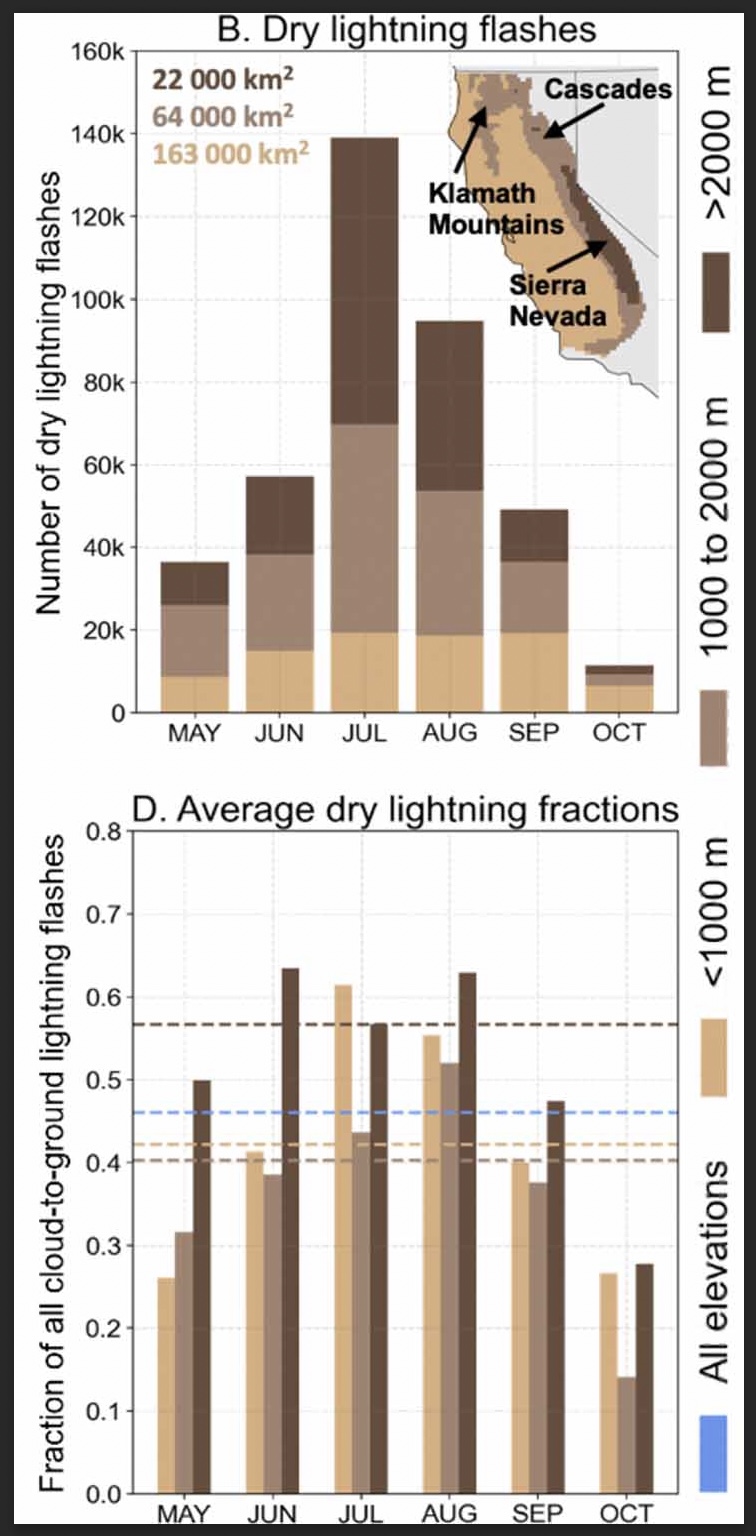
A group of six researchers who studied the occurrence and characteristics of cloud to ground lightning in Central and Northern California found that nearly half, 46 percent, was dry, accompanied by less than 0.1 inch of precipitation.
Of course dry lightning is the bane of land managers and is much more likely to ignite a wildfire than a wet thunderstorm. And on the occasions when there are thousands of down strikes, it can overwhelm the capacity to suppress what can be hundreds of fires.
The six scientists used daily gridded lightning and precipitation observations (1987–2020) in combination with atmospheric reanalyses, to characterize the climatology of dry lightning and the associated meteorological conditions during the warm season (May–October) when wildfire risk is highest.
The paper the group produced is available as open source: “Meteorological and geographical factors associated with dry lightning in central and northern California.”
Daniel Swain, a prolific user of Twitter, used the platform today to highlight some of the group’s findings. In the tweet below, click on “read reply” to see more discussion and illustrations.
We assess regional-scale atmospheric conditions favorable for dry lightning in central & northern California (N&C CA), as well as seasonality. We find that nearly half of all lightning strikes in N&C CA are “dry” (accompanied by <0.10 in. of rain). (2/n) https://t.co/DkooDBG0gg pic.twitter.com/1eZpRIG9cX
— Daniel Swain (@Weather_West) August 8, 2022
The six researchers who participated in the project were Dmitri A. Kalashnikov, John T. Abatzoglou, Nicholas J. Nauslar, Daniel L. Swain, Danielle Touma, and Deepti Singh.

Hi Bill and Readers,
Have been doing what Scientists term Literature Search. And I find that several (if not all) of these six scientists had the same major professor, Noah Diffenbaugh, at Stanford University. I write this comment to clarify ““These six scientists are not only great SCIENTISTS who have reported the results of their years of observations and study; they know history and are clever. Given the case of Continental Drift, they knew (assumed) that there would be many lesser METEOROLOGISTS who would not believe the result of their years of study. So they waited until there was these well documented cases of lighting caused WILDFIRES which no one could question.” Which implies I considered these scientists to be DEVIOUS: “showing a skillful use of underhanded tactics to achieve goals” (New Oxford American Dictionary)
As I read and pondered, I finally saw that CLIMATE is always changing just as the weather can change drastically from one day to the next. It is generally accepted by SCIENTISTS that that the northern portions of the continents of the Northern Hemisphere have been glaciated by thick ice sheets down to, and sometimes a little beyond, 45 degrees north. And that the last glaciation occurred about 12000 years ago. Obviously much of this last ice has melted except at the higher elevations. And we see that even a good portion of the ice on the Arctic Ocean, which is seldom freezes thicker than 20 feet, melts by the end of the summer season. Presently observed fact.
It would not surprise me that these six scientists will quickly take advantage of Impressive fire whirl on the Sam Fire in LA County (August 11) for the video of the fire whirl is an observed fact and not just something some scientists have imaged.
Hi Bill and Readers,
These six scientists are not only great SCIENTISTS who have reported the results of their years of observations and study; they know history and are clever. Given the case of Continental Drift, they knew (assumed) that there would be many lesser METEOROLOGISTS who would not believe the result of their years of study. So they waited until there was these well documented cases of lighting caused WILDFIRES which no one could question.
Do you really believe they wrote their article in the few days after these confirmed cases of dry lighting cased multiple spot Wildfires where it lighting seldom occurs. They had studied the history of wildfires which had caused the greatest destruction.
People cannot ignore this destruction and what Wildfire fighters do. You and these six scientists are doing a great service to reestablishing what SCIENCE is meant to be. The study of historical data which is a fact and not imagined. I write this comment so you and the readers do not miss the fact of these six scientists’ article.
Key wording in the graph is flashes. Show me a graph of confirmed cloud to ground strikes and precip totals for those.
This is a rare example of SCIENCE based upon OBSERVATION (MEASUREMENTS). With the critical measurements and words accurately defined as they need be. The scientists involved are experienced with the ideas and data they cite.
I thank Bill for his efforts to keep reader informed and suggest he bring this article to the attention of Princplia Scientific International (PSI) because they have larger readership, however its articles do not have the quality of Wildfire Today articles which is focus on reporting observations of wildfires.
While these 6 scientists report that what has been occurring in the last few weeks is rare, they maybe overlook that these recent wildfires are sometimes burning where there have been previous wildfires in the past few decade and it needs to be noticed that data being cited was not available half a century ago. Or, in some cases less than two decades ago.